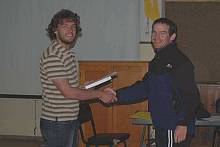SAEON Graduate Student Network holds Indibano
|
From the four corners of South Africa we came …
Nineteen Honours, Masters and PhD students - all of us involved in environment-related studies - convened at de Hoop Nature Reserve in the Western Cape in August to attend the second SAEON Graduate Student Network (GSN) workshop.
Funded by SAEON, the workshop was primarily geared for students interested in long-term ecological research (LTER) of the Earth systems and biodiversity.
The main objective of the Indibano, a … word meaning “get-together” or “gathering”, was to expose students to ecological research, marine protected areas, LTER, statistical R-environment, environmental economics and scientific presentation. We were also introduced to the newly formed SAEON Fynbos Node and its role in LTER.
De Hoop Nature Reserve - a marine protected area and one of the largest natural areas managed by CapeNature - forms part of the world’s smallest and most threatened plant kingdom, the Cape Floral Kingdom. Fynbos, the dominant vegetation group, is largely confined to nutrient-poor soils in the winter rainfall areas of the Western Cape, such as found in De Hoop Nature Reserve.
The students represented several universities (Rhodes, Cape Town, Johannesburg, KwaZulu-Natal, Pretoria, Venda, and the Witwatersrand) and research institutes (Council for Scientific and Industrial Research, SAEON and South African National Parks).
On our arrival in Cape Town, we travelled by bus through Bredasdorp to de Hoop Nature Reserve. After a long bus journey we settled at Potberg Environmental Education Centre, where we were joined by Prof William Bond of UCT’s Botany Department - our “camp dad” for the first two days.
Prof Bond’s talk on the first evening gave us a brief overview of his career as a scientist, but perhaps more importantly, he engaged us on how to become scientists, how to make ourselves known or recognised in die field of science and technology, and how to take science to the public through popular talks and articles.
On the second day we went hiking to Potberg Mountain (“the pot mountain”), but the trip was cut short due to rain. On the hiking trail Prof Bond described many of the interesting and complex aspects of fynbos, and pointed out a few of the diverse plants and some of the life history differences between them. Later that day we had the opportunity to present our projects, after which Prof Bond gave each student some very useful comments and suggestions.
Day three was dedicated to Dr Res Altwegg from the South African National Biodiversity Institute (SANBI) who gave us an introductory course in the open-source statistical package, R, followed by exercises and later analyses of our own data using R. Dr Altwegg went out of his way to respond to the students’ questions and queries, ably assisted by Di Southey, one of the GSN committee members.
The economics of the environment
On day four, Dr Beatrice Conradie from UCT’s Economics Department braved the cold to join us for the morning and give us a short course in Environmental Economics. In the afternoon we went on a short field trip to visit some of the long-term exclusion plots used for determining the effect of grazing exclusion on the renosterveld. After the field trip some students climbed up the mountain to Black Eagle Cave. Later that evening it was time for the SAEON GSN committee members to give their presentations.
On day five of the Indibano we visited de Hoop Nature Reserve’s main camp, the vlei, and later Koppie Alleen (“solitary hill”) and the beach. The day was spent bird watching, examining the variety of plants and walking along the vlei. We also spent time walking on the beach and watching whales. Angela Mead, a GSN committee member and UCT PhD student, introduced us to the rich diversity of the rocky shore area.
On the final day of the workshop, we were each presented with an attendance certificate. Trevor McIntyre from the University of Pretoria won the prize for the best presentation for his talk entitled Temporal variation of ocean temperature as measured by seal-borne instrumentation. He received a certificate and a guidebook on fynbos sponsored by SANBI.
Second and third prize went to Ruwen Pillay (CSIR/UKZN) and Batandwa Alperstein (UCT) respectively. Ruwen’s talk was on sponge fauna diversity on the east coast of South Africa and Batadwa’s dealt with the impact of natural resource scarcity on the economic mobility of rural South African Youth.
On behalf of all the Indibano participants, the members of the GSN would like to thank SAEON for sponsoring this workshop. We would also like to thank Eva Mudau of the SAEON National Office for assisting with the logistics.
| What the Indibano delegates had to say:
“The choice of area for the Indibano was ideal as it gave us an opportunity to experience the surrounding fynbos.” "The Indibano exposed us to different opinions and this was thought-provoking.” “What an awesome time! Stunning setting, a brilliant introduction to some new concepts and invaluable networking! See you next year!” “The Indibano programme content was brilliant and it was awesome learning from the guest speakers.” “All the guest speakers were informative and entertaining. It was especially useful that they were all approachable and easy to engage with.” “The content was interesting and diverse.” “The Indibano was very well run and everything went smoothly.” “All in all, I think the committee members really excelled and put together a great GSN Indibano.” “The logistics were excellent. The food was divine and the accommodation is getting better every year.” |





